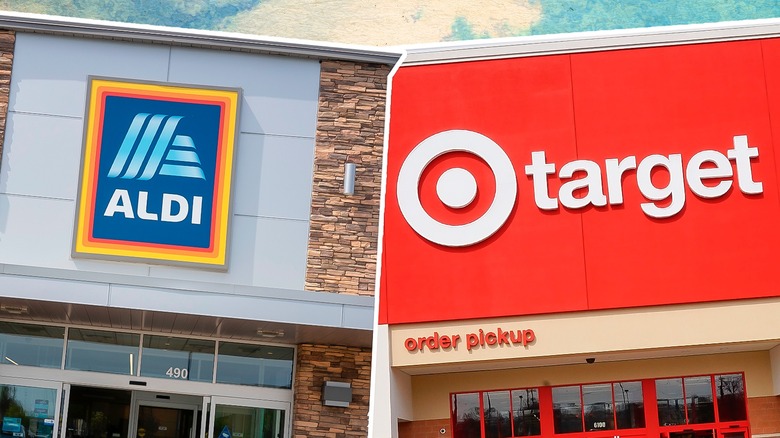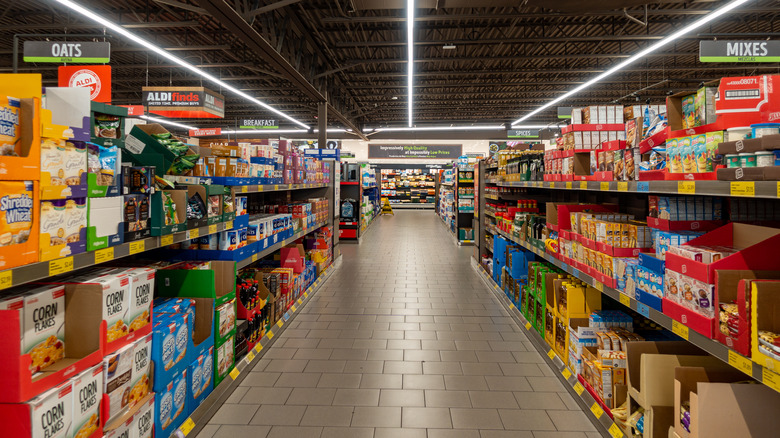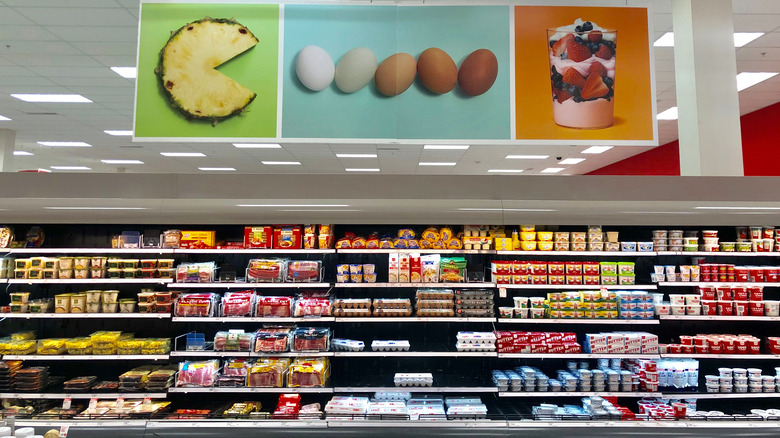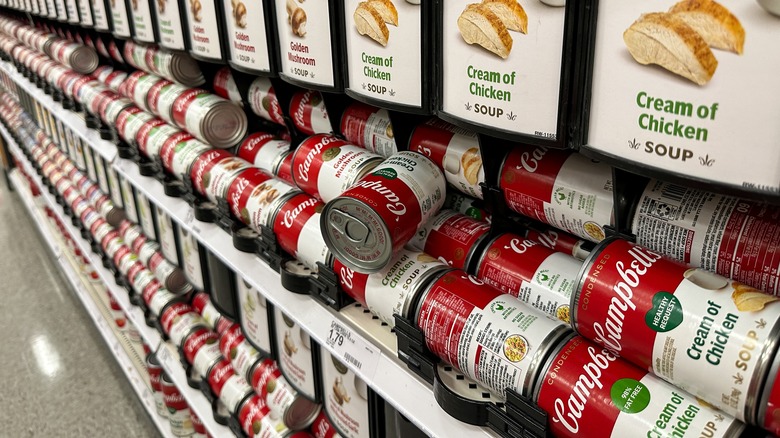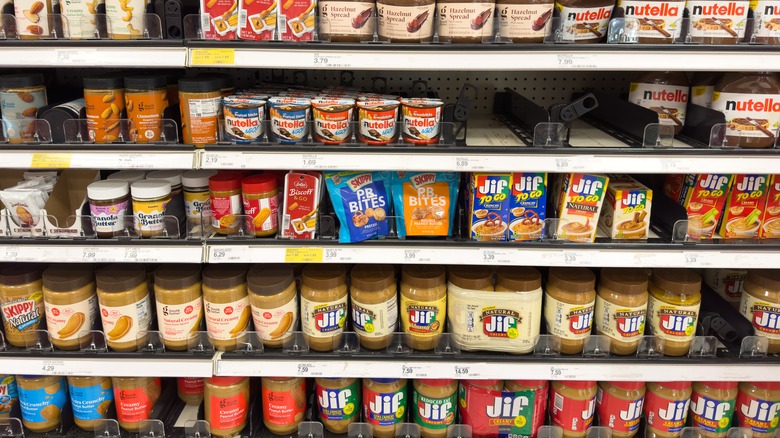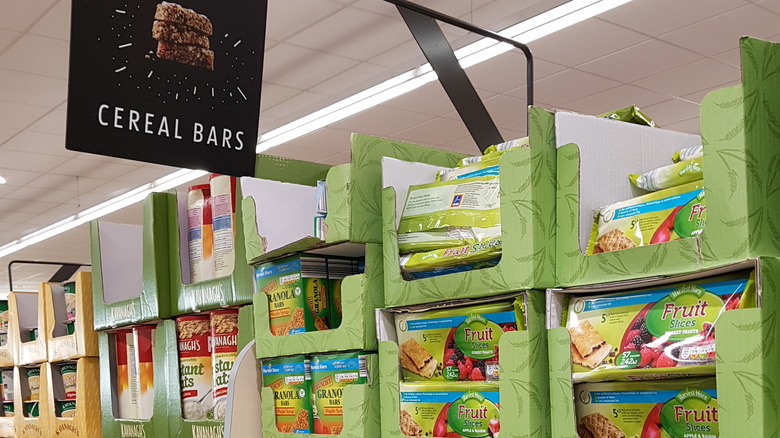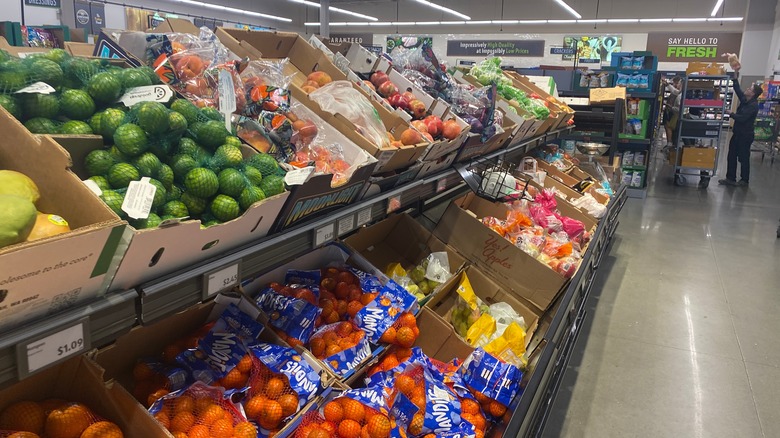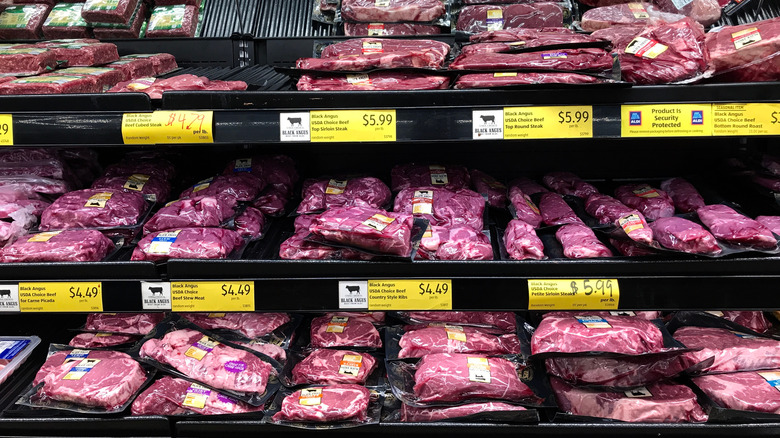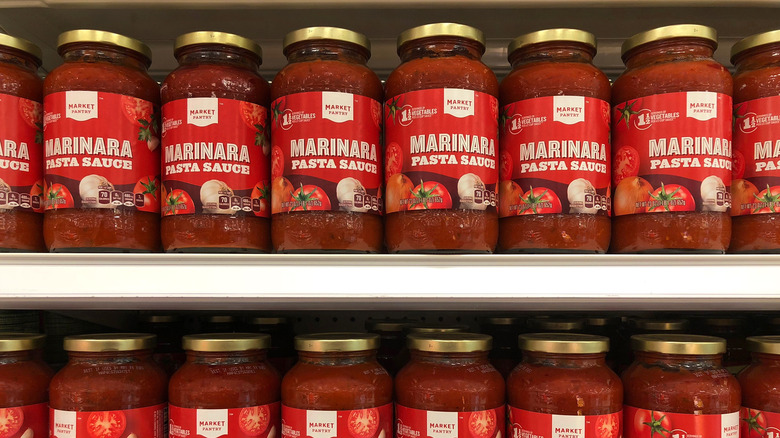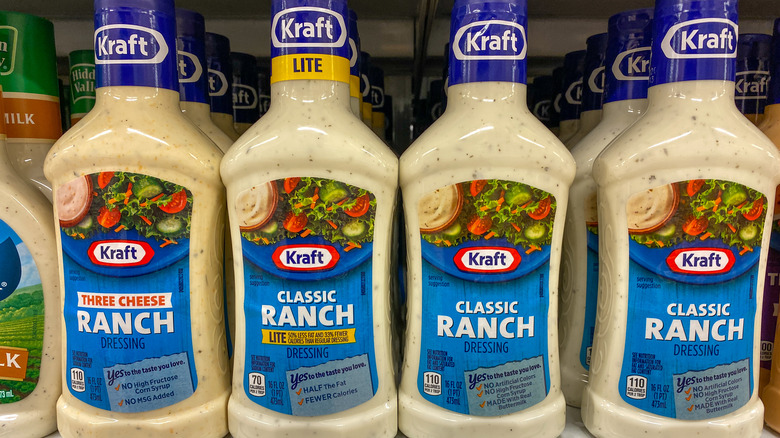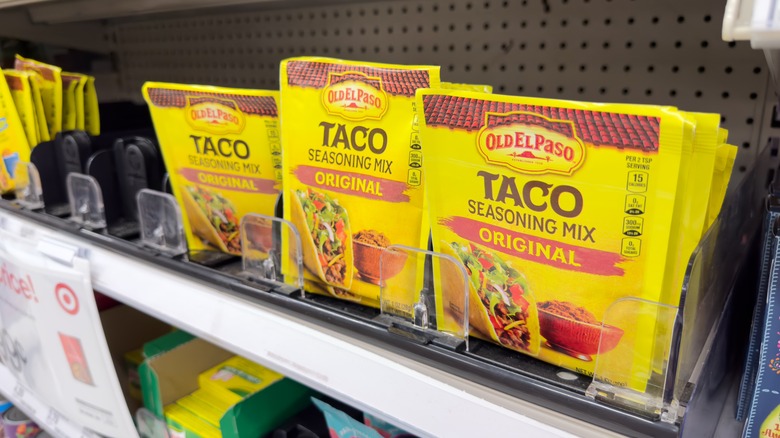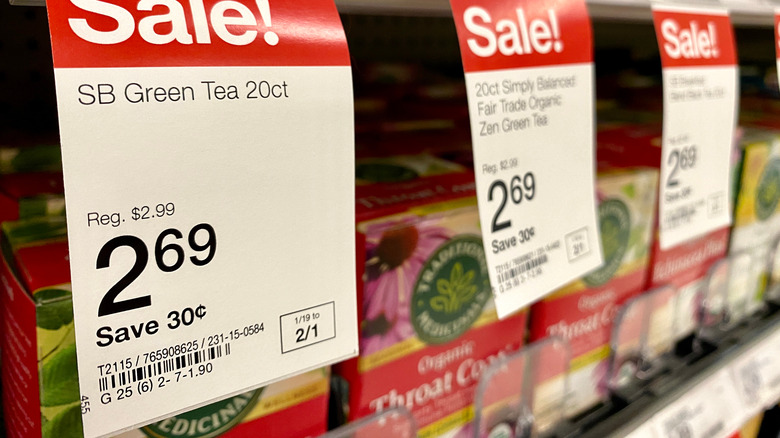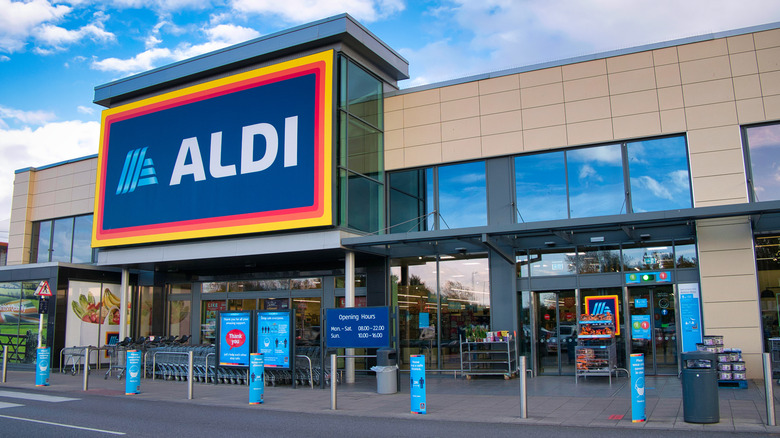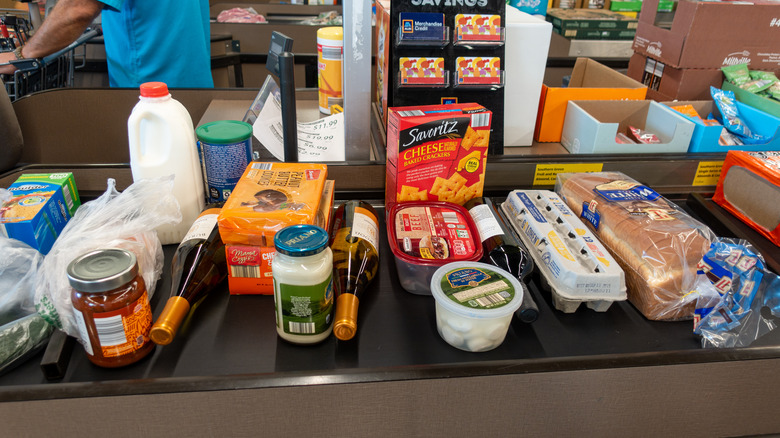Aldi Vs Target: Which Offers Better Value For Groceries?
Aldi and Target both offer great deals on groceries, but when it comes down to it, one of the two has a better value on the majority of products. Most people want to get in and out quickly with their purchases for the week, and if they can spend a little less while doing so, all the better. We'll take a look at about 30 typical food items needed to make simple meals and pit Target and Aldi against each other.
First, there's the nitpicking — which items are cheaper and which store sells all the components of a meal at a better value. If you want to split your shopping list between the two supermarkets, this will guide you through what to buy at Aldi and what to pick up at Target. Then, there's the big picture — where can you purchase your whole grocery list for less, even if a few products are slightly more expensive? How much can you lower your weekly spending by doing this?
The prices mentioned here are accurate as of September 2024 for Aldi and Target's online stores. Grocery prices and stock fluctuate week-to-week and by season. Certain items are more expensive in one state or location than in another. The picture painted here, though, portrays whether Target or Aldi generally offers a better value, and that should hold true even if prices change.
Aldi has cheaper milk and off-brand cereal
Head to Aldi to get the best deals on cereal and milk. For example, a gallon of Friendly Farms 2% milk from Aldi costs $2.85 and Millville Honey Nut Crispy Oats go for about $3. The total price of breakfast would be $5.90. Target, on the other hand, is slightly more expensive for store-brand products but offers a wider selection of name brands. The equivalent products from Target's Good & Gather brand each cost just under $3.40, coming to a total of about $6.80. The Millville's cereal box is larger at 19.5 ounces while Good & Gather's box contains 12.25 ounces. That makes the per-ounce price at Aldi (15 cents) around half of Target's (28 cents).
If off-brand cereal isn't your thing and you love General Mills, you'll probably buy Honey Nut Cheerios instead of Millville or Good & Gather. In that case, you'll find the lowest price at Target — it's about 5 cents per ounce cheaper. Other popular name-brand cereals also tend to cost slightly more at Aldi, when in stock. So, head to Aldi for milk and cheap knock-off cereal, but run to Target for fancy name-brand cereal.
Eggs and bacon are $1.50 more at Target
There's nothing quite like a hearty weekend breakfast to give you energy for your projects around the house, but you probably don't want to spend a fortune on eggs and bacon. If you buy them at Target, you'll likely pay about $1.40 more than you will if you purchase similar items at Aldi. Target sells Good & Gather white or brown eggs for nearly $4 a dozen and $4 for 16 ounces of Market Pantry Hardwood Bacon. That puts a price of nearly $9 on your typical Saturday morning breakfast.
Over at Aldi, you'll find white eggs for about $3.60 (brown eggs cost nearly $4) and 16 ounces of Appleton Farms Bacon for just under $4. The total for your early morning meal would be about $7.60. Even though the price is lower, the quality of Aldi's products is close to that of Target's, so there's no reason to spend more.
Grilled cheese and tomato soup are similarly priced
Grilled cheese and tomato soup is a favorite for kids and adults alike. If you eat it regularly, you'll want to know where to get the best price on all the ingredients, but it turns out it doesn't make much difference if you go to Target or Aldi — the price gap for this dish is just slightly more than 50 cents.
First, Campbell's tomato soup sells for exactly $1.39 at both stores. If you use white bread and provolone cheese, you'll find them for just a few cents less at Aldi. There, 20 ounces of L'Oven Fresh bread cost $1.55, and 8 ounces of Happy Farms provolone comes out to nearly $1.90. Similar products from Target by Bimbo and Good & Gather brands cost around $2 each.
The total you'd fork over at Target is about $5.40 while, at Aldi, it's just under $5. If Aldi is farther from your home than Target, you'll probably spend more on the gas to get there than you would save.
Aldi has a better deal on PB&J
If you're packing school lunches, PB&J sandwiches are probably on the menu. Making them every day can add up, though. Unfortunately, you won't find a way to cut costs much by picking the cheaper grocery store, as the prices at Aldi are just minimally lower. At first glance it can be deceiving, since Aldi's private brand products come in larger containers than Good & Gather, making them seem more expensive. However, closer examination reveals the per-ounce prices are similar. That said, Target has a wider selection of peanut butter if you're specific about the brand.
Target's Good & Gather 16 ounce peanut butter has a price tag of about $2, whereas an 18-ounce jar of Peanut Delight peanut butter at Aldi costs $2.35. That makes Target's product about 1 cent cheaper per ounce, which is negligible. Meanwhile, jelly and bread are both less expensive at Aldi. There, 30 ounces of Berryhill Concord grape jelly costs $2.85, compared with an 18-ounce jar of Market Pantry jelly at Target for around $2.20. Aldi's comes out to about 2 cents cheaper per ounce. Finally, a bag of white bread from Aldi is close to 50 cents less than at Target.
Aldi's cereal bars are cheaper, but smaller
Cereal bars are a must-have on any shopping list. They go great in sack lunches and are the perfect snack in most situations. They also fit comfortably in a pocket or purse so you can take them along almost anywhere in case you get hungry. Of course, you'll want to buy the cheapest high-quality granola bar possible. If that's the case, Aldi is the place.
A 7.4-ounce box of Quaker chewy chocolate chip granola bars costs about $2.70 (around 36 cents per ounce) at Target. The store also sells Good & Gather chocolate chip granola bars, but they are more expensive at about 50 cents per ounce. Meanwhile, an 8.4-ounce box of Aldi's Millville chewy granola bars costs just under $2 (around 23 cents per ounce). Quaker's box contains five larger bars while Millville's holds 10 smaller ones. Both brands have similar ingredient lists and nutrition facts, making the store-brand option from Aldi a better value.
Fruit is much cheaper at Aldi
Fruit is a great option for healthy snacks, and your family may go through several pounds of it in a week. Choosing the best-tasting fruit is likely your priority number one, but number two is probably getting it at the best price. You won't find an easy go-to store for the first, but the second has a clear answer — fruit at Aldi is significantly cheaper than at Target.
If you put navel oranges, Cosmic Crisp apples, and bananas in your cart, you will see a big price difference. First, Target lists a 3-pound bag of navel oranges for about $4.70. The same size format at Aldi appears on the online shop for $3.55. That's over a dollar of difference for just one product. You'll get Cosmic Crisp apples at Aldi for 20 cents less than at Target — about $3.40 versus $3.20 for a 2-pound bag. Finally, you can buy bananas at Aldi for half the price, but only because Target solely offers the more expensive organic kind. Two pounds of the yellow fruit from Aldi cost about $1, whereas at Target they go for $2. Buying organic bananas at Aldi drives the price up to about $1.50 — still cheaper than Target. That comes out to about $2.30 of total savings by buying fruit at Aldi instead of at Target.
Aldi has a lower price on steak and mashed potatoes
Steak with mashed potatoes is a favorite meal for many families, but also a pricey one. Since you're already spending more by purchasing beef, finding the best deal will make it hurt a little less. You can do that by shopping at Aldi where meat prices are lower. A pound of USDA Choice Angus skirt steak costs about $9, compared to Target where the same cut goes for around $11.60 per pound.
Aldi also has lower prices on the potatoes, butter, and milk you'll need for the side dish. Ten pounds of russet potatoes cost about $6 at Target, but only $4.20 at Aldi. Aldi also has a larger selection of potatoes than the competition, offering bags of large yellow potatoes which make the creamiest mashed potatoes. Target, on the other hand, only offers baby-sized yellows.
Finally, there are smaller price differences on the dairy products — both are lower at Aldi by about 30 cents for butter and a little over 50 cents for milk. Altogether, you'll spend about $4.80 less at Aldi on the ingredients to make steak and mashed potatoes, and that difference will be even larger if you're buy more than 1 pound of meat.
Spaghetti costs about the same at Aldi and Target
Spaghetti with jarred pasta sauce and frozen meatballs is one of the easiest meals to make. Boil water for the pasta, heat the sauce, microwave the meatballs, and in about 15 minutes, everyone is eating and happy. It's also one of the first meals you can teach your kids to make for themselves. So, spaghetti likely makes a weekly (or more frequent — no one is judging here) appearance at your house, which is a good reason to find the best deal on the ingredients. If you do, you'll find that Target and Aldi have similar prices.
A pound of spaghetti sells for about the same price at either store. Two pounds of Target's Good & Gather noodles and Aldi's Reggano spaghetti both cost about $1.90. Pasta sauce follows the same trend, with Good & Gather selling for just under $1.70 and Reggano for about $1.75. Meatballs are a cent cheaper per ounce at Aldi if you buy the Bremer brand instead of Good & Gather at Target — that's a tiny difference too. Finally, an 8-ounce container of grated Parmesan cheese is where you'll find the biggest difference; it's about $3 at Target versus $3.25 at Aldi.
Aldi has cheaper ingredients for salad
There's nothing like a refreshing crisp lettuce salad with sweet tomatoes, avocado, and some grated carrots, enjoyed as a side dish or bulked up into a main. If you buy the ingredients at Aldi, you'll likely spend around a dollar less than you would at Target.
Iceberg lettuce and a 16-ounce bottle of Market Pantry ranch dressing have a slightly lower price tag at Target — around $4 for both. Aldi sells the same products, except the ranch is Tuscan Garden brand, for a total of about $4.20. Conversely, individual avocados are 20 cents cheaper at Aldi. A 2-pound bag of carrots is cheaper at Aldi too, selling for around $1.70 versus $2.30 at Target. Roma tomatoes are where you'll find the biggest gap — they sell for just 85 cents per pound at Aldi, but nearly $1.40 per pound at Target. The total for salads comes out to $7.55 at Aldi versus $8.70 at Target.
Aldi sells more affordable taco supplies
Making a simple taco recipe is almost as easy as spaghetti, so this is another school night favorite. That also means families appreciate finding the ingredients for this dish at the lowest price — and they can do that at Aldi. There are an infinite number of fillings you can put in a taco shell, but if you're going for traditional ground beef tacos, you'll find a huge advantage to buying the components at Aldi.
A pound of 85% lean meat at Target costs about $6.45, while the same product goes for around $5 at Aldi. Next, Old El Paso taco shells at Target are about 50 cents more expensive than Aldi's Casa Mamita brand. On top of that, Casa Mamita packs in 12 shells while Old El Paso only puts 10 in a pack. Shredded Mexican-style cheese also has a slightly lower price at Aldi, at 27 cents per ounce versus 29 cents per ounce. Finally, Casa Mamita salsa is also cheaper than Good & Gather's version, but only by 15 cents. Altogether, you could spend about $2.25 less if you shop for taco supplies at Aldi.
Target has a larger hot beverage selection, but they're cheaper at Aldi
Buying tea and coffee at Aldi costs less than doing so at Target. The main reason to shop for hot beverages at Target is a year-round hot chocolate stock and fancier tea options. Aldi only puts hot cocoa mix on the shelves in the winter. If you shop at Aldi in the spring, summer, or early fall, you'll have to make do with just tea and coffee.
Although Aldi's selection of teas and coffees is minimalistic — you can find about two or three brands of each — it is much cheaper than Target's offerings. For example, a box of Benner tea costs around $2 at Aldi, while Target's Good & Gather green tea sells for around $3.70. Both contain 20 bags. Café Bustelo sells at both stores but is about 50 cents less at Aldi. The smaller selection at Aldi isn't an issue, because Café Bustelo and Benner tea both have a great taste.
Final Verdict
If you're looking to spend the very least possible on groceries, you should split your shopping list between Target and Aldi. Raw, basic ingredients tend to cost less at Aldi, but more highly processed foods have similar prices at both and sometimes cost less at Target. Additionally, name-brand foods are occasionally cheaper at Target. Meat and produce are the areas where the largest price difference exists, and they generally sell for less at Aldi.
If your weekly shopping trip takes you to just one store, you should go to Aldi. Adding up the prices of the essential grocery items listed in this article resulted in the virtual cart at Aldi having a final price of about $90 — around $10 less than Target. That's about 10% less which could build up over time. For example, if you spend $1,000 dollars a month at Target to feed your family of four, you would spend $900 if you shopped at Aldi.
Methodology
To judge which store offered a better value, I wanted to look at the prices of products consumed by many households. So, I jotted down a list of easy meals and snacks with ingredients that cooks could use in several dishes, providing an overview of different sections of the stores — meat, dairy, produce, and dry goods. Armed with my menu and shopping list, I logged onto Aldi and Target's online stores and put my groceries into virtual carts to compare prices. Where possible, I compared the stores' prices for the same name brand or Target's store brands against Aldi's store brands. I paid attention to the weight, size, and quality of the ingredients in each product.
For each meal, I picked a winner — the store that sells the necessary items to make that dish at a lower price. Then, to reach a final verdict, I compared the total in each cart to see how big of a difference there was between the stores. I was careful to consider additional factors that could make one cart falsely appear more expensive than the other. For example, Target's website automatically added over $20 for the cut of meat I picked. That was the maximum they could charge me, but the price would depend on the actual weight of the steaks in my shopping bag at the physical location. To compare value more fairly, I adjusted that price to 1 pound of meat at both stores.
